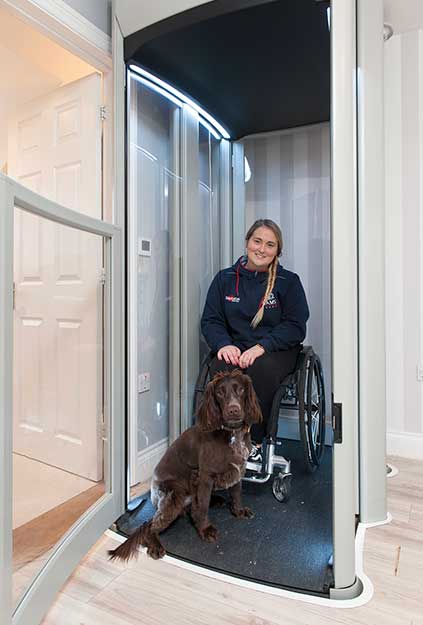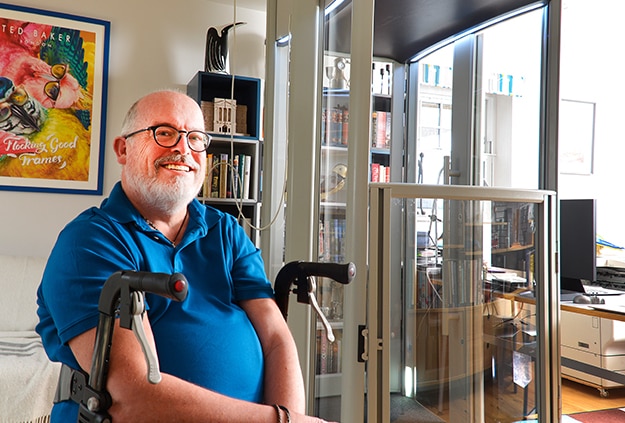Five reasons why you might prescribe a homelift
A simple guide for Occupational Therapists
If you are supporting a client with restricted mobility, you are continually aware they might be at risk of a fall when using the stairs in their home. Falls can result in medical intervention as well as ongoing care during rehabilitation. In addition, an initial fall has been proven to lead to further falls as confidence is lost and mobility compromised.
As healthcare professionals, you might be looking to specify equipment that can negate crisis situations whilst providing long-term suitability and value – a homelift is becoming increasingly popular as an appropriate solution. In comparison to traditional stairlifts, homelifts provide future-proofed support for changing requirements and may reduce transfer risks for semi-ambulant individuals and wheelchair users.
So, when is the prescription of a homelift appropriate? Here are five considerations for positive outcomes:
- Utilisation of the entire home
- Future-proofing occupational performance
- Independence for wheelchair users
- Supporting increased dementia diagnoses
- Post hospital reablement
- Utilisation of the entire home
The location, design and use of a staircase may influence your decision to recommend a homelift.
For example, easy access to an upstairs bedroom and bathroom is essential for maintaining hygiene and health. If stairs, or split levels are barriers, then individuals may begin sleeping and washing downstairs – typically using a chair as a bed and not cleaning thoroughly. This is an unhealthy, unsustainable scenario which will lead to further issues and a loss of self-esteem.
If a staircase is narrow, steep or winding, as common in older properties across the UK, a homelift may also benefit other ambulant household residents who continue to use the stairs. The alternative option of a stairlift can cause issues with its seat and rails which encroach on steps and present a trip hazard, especially if areas are dimly lit. In contrast, a homelift ensures an existing staircase remains clear of obstacles, and hallways and landings are kept free of mobility equipment.
- Future-proofing occupational performance
When assessing client wants, needs and risks, it is important to evaluate how these criteria may change over time. For instance, individuals with degenerative or neurological conditions such as MS will present with increased mobility difficulties as they age, hence flexible equipment for continued accessibility upstairs is required. In these scenarios, homelifts have been proven to provide the necessary access with designs that provide long-lasting suitability. These products prevent unnecessary building adaptations and care costs in the future, and local authorities are increasingly appreciating the budgetary advantages of homelifts, particularly within the context of Disabled Facilities Grants.
As well as practical and lifestyle benefits, the emotional advantages of accessible living tend to boost occupational performance. Confidence and contentment are enhanced which result in improved mood and a more positive outlook on life. Even if total ambulant independence is not possible, a homelift will accommodate equipment such as a walker and improve moving and handling by carers. In turn the risk of musculoskeletal injury for both carers and clients is reduced.
- Independence for wheelchair users
Clients who live in multi-level homes and use a wheelchair should be considered as candidates for a homelift. Commonly, wheelchair users don’t feel comfortable with the transfer process associated with stairlifts, especially at the top of a stairwell. Safety concerns can be heightened if strength and balance are inconsistent or transfer experience is limited. A mobile or ceiling track hoist can offer an alternative for accessing a stairlift seat, however this process is time-consuming and surrounding space is typically an issue. In contrast, a homelift provides seamless accessibility without the need to transfer out of a wheelchair and into another one on a separate floor – this reduces clutter and trip hazards.
- Supporting increased dementia diagnoses
A homelift should be considered for clients who experience difficulties with executive function. As an assessing Occupational Therapist, you will naturally consider the risks a staircase presents whilst factoring in a client’s working memory, attention and spatial awareness, all common problems in those with dementia. In this scenario, a Stiltz Duo+ Homelift may provide safer transit between floors, as a client with dementia could ignore a stairlift in favour of stair usage or forget to use a safety belt. Anxiety levels may also rise when travelling up the stairs on a seat, whereas a homelift provides a secure and reassuring space. Depending on client need, models with solid or clear sides are available offering either a safe, enclosed environment or outward visibility while travelling between floors. Peace of mind can be enhanced by well-thought-out features such as a safety light curtain which provides anti-entrapment protection – installed as standard in a Stiltz homelift. Read more about our safety features.
- Post hospital reablement
The straightforward access provided by a homelift benefits clients with a wide range of conditions. These include neurological diseases, visual impairment, learning difficulties, spinal injury, arthritis, COPD, MS and dementia to name just a few. Wherever strength, balance and grip are reduced, the use of a homelift will negate trips and falls associated with using stairs.
COVID-19
2020 has seen an increase of homelift installations supporting clients affected by COVID-19 and associated respiratory issues. The physical effort of climbing stairs or transferring into a stairlift may be too demanding, resulting in compromised living or increased risk while attempting to move around the home.
Irrespective of condition, faster reablement within the community following hospitalisation can be facilitated by earlier mobility equipment intervention during a care pathway. This will provide better outcomes in the long term.

As healthcare professionals, you might be looking to specify equipment that can negate crisis situations whilst providing long-term suitability and value – a homelift is becoming increasingly popular as an appropriate solution.







